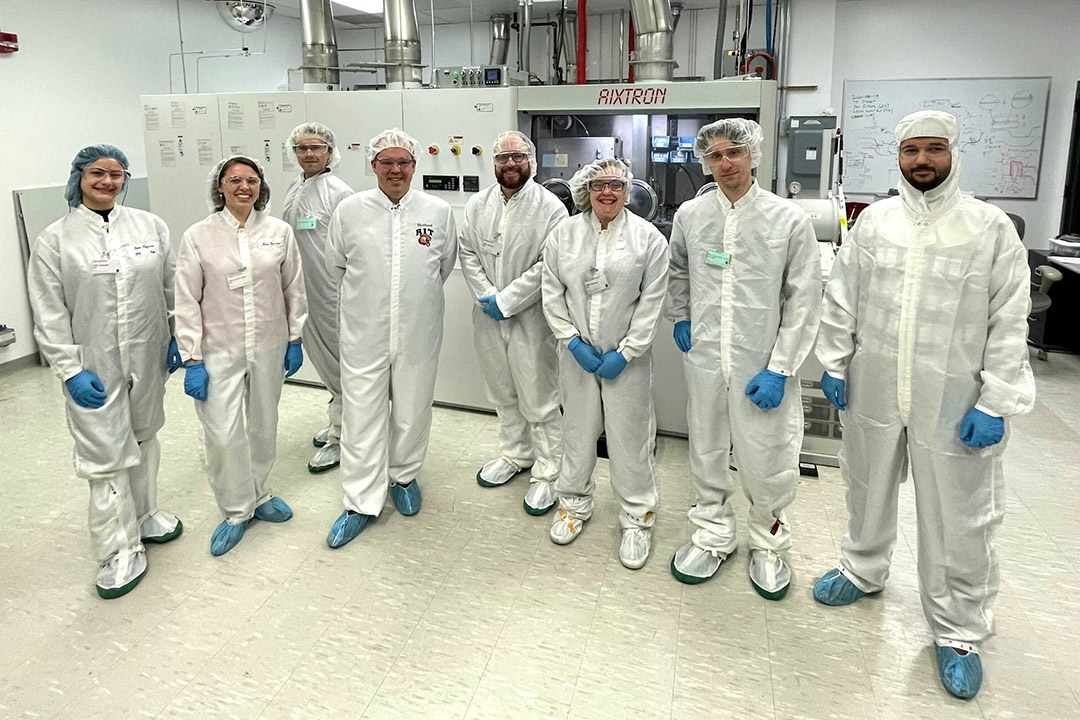NASA awardee working on lunar rover technology
Katelynn Fleming’s work on laser power converters can be used on the moon and on Earth
Julia D’Rosario
Fleming aims to use her studies across STEM fields and in Spanish to benefit others. Her research on laser power converters for lunar rovers is funded by her 2022 NASA Space Technology Graduate Research Opportunity (NSTGRO) award. From left to right, Julia D’Rosario, Fleming, Andrew Sindermann, Seth Hubbard, Steve Polly, Emily Kessler-Lewis, Brandon Bogner, and Salwan Omar.
RIT student Katelynn Fleming is hard at work making new discoveries on the moon. But her ultimate goal is to use technology to help all of us on Earth.
Fleming, a microsystems engineering Ph.D. student from Long Valley, N.J., recently won a 2022 NASA Space Technology Graduate Research Opportunity (NSTGRO) award. As part of this award, she receives funding for her research and will work at NASA centers as part of the visiting technologist experiences. She will also have the honor of working alongside Geoffrey Landis, who has worked on multiple Mars exploration missions and will serve as her NASA subject matter expert mentor.
Benjamin Vaughan
Katelynn Fleming, microsystems engineering Ph.D. student.
“One thing I’m really excited about is the visiting technologist experiences,” Fleming said. “They will allow me to actually experience these areas and make a lot of connections but also decide what kind of environment I want to work in.”
The project that Fleming will be working on with the NSTGRO grant centers around laser power converters, specifically for lunar rovers. “A laser power converter is a device that allows you to transmit power wirelessly by using power to generate a laser beam which travels through the air. Then, it is collected at a laser power converter which turns it back into electricity,” Fleming said.
She envisions this technology enabling a pair of lunar rovers to explore the craters on the moon where sunlight cannot reach. One rover would remain at the edge of the crater and would beam power to the other rover exploring inside the crater. The exploring rover could then beam images and other data back to the first rover. This approach can help scientists look for ice or make other discoveries.
Fleming has worked in many areas, including physics, spectroscopy, high-energy physics, microelectronic engineering, and optics, and she originally applied to RIT for astrophysical sciences and technology. Fleming explained that “the person I was talking with happened to ask what I want to do, and I said I’d really like to work on photovoltaics.”
Unfortunately, that area was housed in a different department. She switched programs and connected with faculty who work in this field, like her advisor Seth Hubbard, a professor in the School of Physics and Astronomy.
“It was really a wild and circuitous route, and took me in an unexpected direction, because I thought I wanted to do physics, but turns out I wanted to be an engineer. I just didn’t know it,” said Fleming.
In addition to her wide-ranging knowledge in technical fields, Fleming also brings the skillset of a second language. She double majored in physics and Spanish for her bachelor’s degree and says that Spanish was a great way to hone her writing and analytical skills.
“Having that global perspective has helped me to frame my ideas of what I think should change in science and decide how I think the community should change to be more inclusive toward everyone.”
Though her current work focuses on the moon, Fleming keeps her sights set on helping others.
“My hope is that this work that we’re doing right now in laser power converters for extraterrestrial exploration will eventually become good enough for us to use in natural disaster areas on Earth. For example, at home my family lost power for three weeks after Hurricane Sandy. My classes were all canceled, I had no school for three weeks, the lights were off, it was the beginning of winter, and people didn’t have heat. We were all clustered together in the library and people who had generators were lined up for hours to buy gasoline. My hope is that one day that would not be necessary because if a natural disaster struck, emergency power could be transported in by beaming. This technology could eventually be used in natural disaster and hard-to-reach zones all over the world.”










